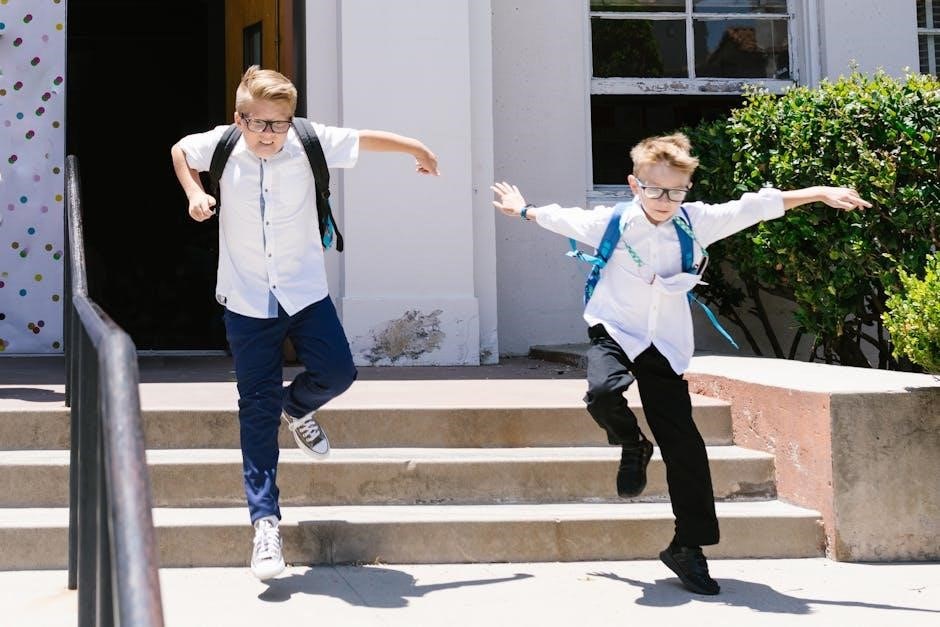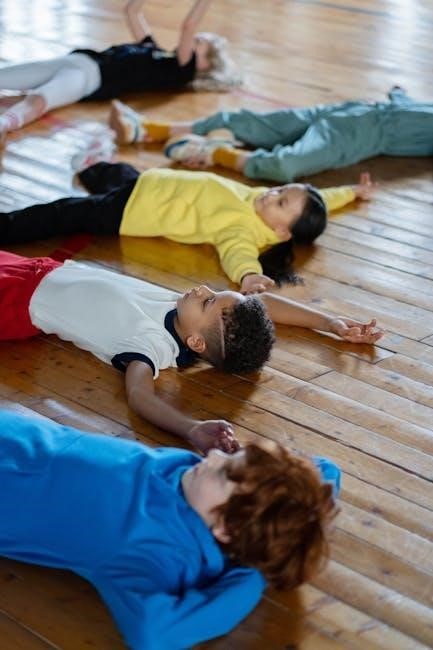Active shooter preparedness is critical for schools to ensure student and staff safety. Recent incidents underscore the need for comprehensive emergency plans and training. This manual provides strategies to mitigate risks and respond effectively during such events, ensuring a safe learning environment.
1;1 The Importance of a Comprehensive Emergency Manual
A comprehensive emergency manual is essential for schools to address active shooter scenarios effectively. It outlines clear protocols, ensuring staff and students know their roles during a crisis. The manual should include evacuation routes, communication strategies, and shelter-in-place procedures. By having a well-structured plan, schools can minimize chaos and prioritize safety. Regular updates to the manual ensure it remains relevant and adaptable to new threats. Training based on the manual helps build confidence and preparedness, creating a safer environment for learning. A detailed manual also aids in coordination with law enforcement, streamlining response efforts. Ultimately, it serves as a critical resource for preventing, mitigating, and recovering from active shooter incidents, safeguarding the school community.
1.2 Recent Incidents Highlighting the Need for Preparedness
Recent incidents of active shooters in schools have underscored the urgent need for preparedness. Events like the Columbine shooting and more recent tragedies have shown how devastating such incidents can be. Data indicates that over 228,000 students have been affected by gun violence in schools since 2000. These incidents highlight the importance of having robust emergency plans in place. Without proper preparation, the risk of harm escalates, and the ability to respond effectively diminishes. Schools must learn from past events to improve safety measures, ensuring staff and students are trained to react swiftly. These tragedies serve as a stark reminder that complacency can have dire consequences, making preparedness a top priority for school safety.
1.3 Purpose of the Manual for High School Safety
This manual is designed to provide high schools with a comprehensive framework to prevent, mitigate, and respond to active shooter incidents. Its purpose is to equip schools with actionable strategies, ensuring the safety of students, staff, and visitors. By outlining clear protocols and best practices, the manual aims to enhance preparedness and minimize risks. It serves as a resource for school administrators, security personnel, and educators to create a secure learning environment. The manual emphasizes proactive measures, such as emergency planning, staff training, and infrastructure improvements, to address potential threats effectively. Its structured approach ensures that schools are well-prepared to handle crises, fostering a culture of safety and resilience within the school community. This guide is essential for schools seeking to protect their most valuable asset—their people.

Understanding the Threat of Active Shooters
Active shooters pose a severe threat to school safety, often acting unpredictably. Understanding their motivations and behaviors is crucial for developing effective prevention and response strategies.
2.1 Defining an Active Shooter Scenario
An active shooter scenario involves an individual actively engaged in killing or attempting to kill people in a confined and populated area, such as a school. These situations are often unpredictable and involve the use of firearms, making them highly lethal. Active shooters may target specific individuals or act opportunistically, increasing the danger. Understanding this definition is crucial for developing effective prevention and response strategies to protect students and staff during such events.

2.2 Behavioral Indicators of Potential Threats

Identifying behavioral indicators of potential threats is crucial for preventing active shooter incidents in schools. These indicators may include sudden behavioral changes, such as increased aggression, fascination with violence, or overt threats; Students or individuals may exhibit signs like social withdrawal, unexplained mood swings, or a fixation on firearms. Monitoring these behaviors can help school staff and administrators intervene early. Additionally, threats made verbally or through written communication should never be ignored. Schools must foster an environment where students feel comfortable reporting concerning behaviors. Early identification and intervention can significantly reduce the risk of an active shooter scenario. Training staff to recognize these signs is essential for maintaining a safe learning environment and ensuring proactive measures are taken to address potential threats before they escalate.
2.3 Statistical Overview of School Shootings in the U.S.
School shootings in the U.S. have seen a disturbing rise over the past two decades. Since the Columbine High School shooting, an estimated 234 schools and over 228,000 students have been directly impacted by gun violence. This alarming trend highlights the urgent need for preparedness and prevention strategies. Active shooter incidents often involve individuals targeting specific victims but may also harm others encountered during the attack; Understanding these patterns is essential for developing effective safety measures; The statistical data underscores the importance of creating robust emergency plans and training programs to mitigate the risks of such events. By analyzing these statistics, schools can better prepare for potential threats and ensure a safer environment for students and staff.

Preparation and Planning Strategies

Developing a school safety action plan, conducting regular drills, and securing infrastructure are key strategies. Training staff and students on emergency protocols ensures preparedness for active shooter scenarios.

3.1 Developing a School Safety Action Plan
A school safety action plan outlines protocols to prevent, mitigate, and respond to threats. It includes emergency procedures, communication strategies, and evacuation routes. The plan should be tailored to the school’s layout and needs, ensuring clarity and accessibility for all staff and students. Regular updates and reviews are essential to adapt to changing circumstances. The plan should also integrate with local law enforcement and emergency services for a coordinated response. Training and drills based on the plan help familiarize everyone with the procedures. By addressing both prevention and response, the action plan serves as a critical foundation for safeguarding the school community during an active shooter event.
3.2 Conducting Regular Active Shooter Drills
Regular active shooter drills are essential for preparing students and staff to respond effectively during an emergency. These drills simulate realistic scenarios, teaching participants to recognize threats and act swiftly. Schools should conduct drills at least twice annually, varying the timing and scenarios to ensure preparedness for different situations. Drills should include evacuation procedures, shelter-in-place strategies, and communication protocols. Participation from local law enforcement can enhance realism and coordination. After each drill, feedback sessions should be held to identify areas for improvement and refine procedures. Ensuring all students and staff are familiar with the protocols minimizes panic and improves response times. Regular drills foster a culture of preparedness, equipping the school community with the skills needed to survive an active shooter event.
3.3 Implementing Secure School Infrastructure
Secure school infrastructure is a critical component of active shooter preparedness. This includes installing reinforced doors, surveillance cameras, and alarms to enhance security. Access control systems, such as secure entry points and ID checks, help prevent unauthorized access. Ensuring natural lighting and clear escape routes can also improve safety. Regular maintenance of infrastructure ensures all systems function effectively during emergencies. These measures create a safer environment and deter potential threats.
3.4 Training Staff and Students on Emergency Protocols
Training staff and students on emergency protocols is essential for effective response during an active shooter event. Regular drills, including active shooter scenarios, help familiarize everyone with evacuation routes, shelter-in-place procedures, and communication strategies. Designating roles, such as who will call 911, ensures clarity during chaos. Practical exercises, like identifying escape paths and assembly points, enhance preparedness. Training also emphasizes staying calm, making quick decisions, and prioritizing safety. Psychological preparedness is equally important, teaching individuals to remain alert and responsive. By involving both staff and students, schools foster a culture of readiness, ensuring everyone knows their responsibilities. Regular updates to protocols keep the school community informed and equipped to handle evolving threats. This collaborative approach strengthens overall safety and resilience in the face of potential dangers.

Response Protocols During an Active Shooter Event
Evacuate if possible, following pre-planned routes. If unable to escape, secure shelter in a locked, barricaded room. Stay low, avoid windows, and remain silent. Do not confront the shooter unless necessary.

4.1 Evacuation Routes and Procedures
Schools must establish clear evacuation routes and procedures to ensure quick and safe exit during an active shooter event. Designate primary and alternate escape paths, ensuring they are free from obstacles. Conduct regular drills to familiarize students and staff with these routes. Identify assembly points outside the building where everyone can gather safely. Train individuals to remain calm, move swiftly, and avoid congregating near windows or doors. Ensure communication with law enforcement, providing updates on the shooter’s location if known. Designate a staff member to account for all individuals at the assembly point. If evacuation is not possible, secure shelter immediately. Always prioritize moving away from the threat while maintaining situational awareness. Accessibility for all students, including those with disabilities, must be integrated into evacuation plans to ensure no one is left behind.
4.2 Shelter-in-Place Strategies
Shelter-in-place is a critical strategy when evacuation is not feasible during an active shooter event. Identify safe rooms with minimal windows and proximity to the building core. Barricade doors using furniture or other objects to prevent entry. Ensure all students and staff remain quiet, out of sight, and away from windows. Designate a person to communicate with law enforcement, confirming the shelter location and shooter activity. Avoid unnecessary movement within the shelter to maintain safety. Stay informed through emergency alerts and follow instructions from authorities. Shelter-in-place remains in effect until law enforcement confirms the threat is neutralized. Always prioritize securing the environment and maintaining calm to protect everyone involved. Regular drills ensure readiness for such scenarios, enhancing the ability to respond effectively during an emergency.
4.3 Communication with Law Enforcement and Emergency Services
Effective communication with law enforcement and emergency services is vital during an active shooter event. Designate a staff member to call 911 immediately, providing the school name, location, and nature of the emergency. Clearly describe the shooter’s location, appearance, and weapons if possible. Stay on the line to relay updates as the situation evolves. Ensure all communication is concise and accurate to avoid misinformation. Use public address systems or emergency alerts to keep students and staff informed while avoiding details that might alert the shooter. Once law enforcement arrives, follow their instructions without hesitation. Establish a reunification point for students and staff outside the building, ensuring accountability and safety. Clear communication channels are essential for a coordinated response, enabling law enforcement to act swiftly and effectively to neutralize the threat.

Recovery and Post-Incident Actions
Recovery involves providing psychological support to students and staff, conducting thorough investigations, and ensuring safety measures are in place to restore a secure learning environment, facilitate community healing, and prevent future incidents.
5.1 Providing Psychological Support to Students and Staff
Providing psychological support is essential for students and staff after an active shooter incident. Schools should offer counseling services, mental health resources, and support groups to address trauma and grief. Trained professionals can help individuals process their experiences and emotions. Creating a safe environment for open discussions and ensuring access to hotlines or anonymous reporting tools can foster trust and encourage seeking help. Additionally, staff training on recognizing signs of distress and connecting individuals to resources is crucial. The focus should be on fostering resilience and promoting a sense of security and well-being within the school community. Recovery efforts must prioritize long-term mental health support to aid healing and restore a positive school culture.
5.2 Conducting a Thorough Investigation and Review
Conducting a thorough investigation and review after an active shooter incident is vital for understanding what happened and preventing future occurrences. This process involves analyzing the sequence of events, identifying vulnerabilities in safety protocols, and evaluating the effectiveness of the response. Schools should collaborate with law enforcement, mental health professionals, and safety experts to gather comprehensive insights. A detailed report should be created, documenting findings and recommendations for improvements. This review should also assess communication strategies, evacuation procedures, and the implementation of emergency protocols. The insights gained from this process are essential for updating safety plans, enhancing training programs, and ensuring that the school community is better prepared for future threats. Transparency and accountability are key to rebuilding trust and improving overall safety measures.
